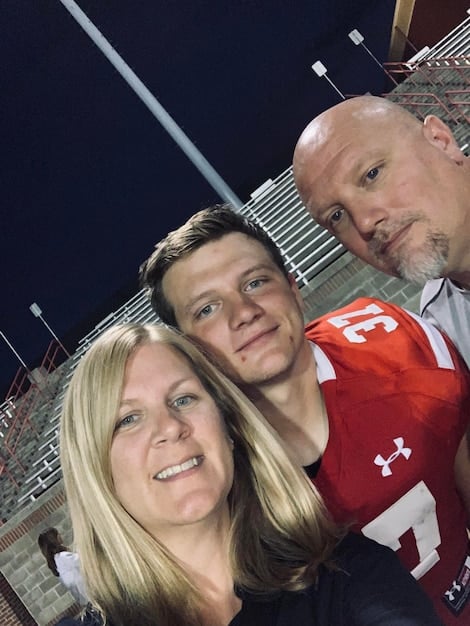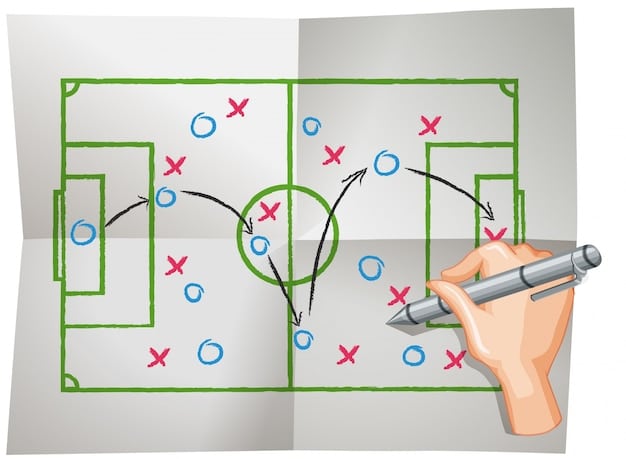Premier League Managerial Styles: Tactical Approaches & Philosophies Compared

Premier League managerial styles encompass diverse tactical approaches and philosophies, ranging from possession-based systems to counter-attacking strategies, all shaped by the manager’s vision and the team’s capabilities for competitive success.
The Premier League is renowned for its intense competition and diverse range of **Premier League managerial styles**. Each manager brings a unique tactical approach and football philosophy to the game, shaping their team’s performance and overall league dynamics.
Understanding Premier League Managerial Styles
Premier League managers’ styles vary significantly, influencing team tactics, player development, and overall performance. Understanding these styles provides insight into the strategic depth of the league.
The Spectrum of Tactical Approaches
Tactical approaches range from possession-based philosophies to direct, counter-attacking styles. Managers adapt their tactics based on player strengths and opponent weaknesses.
- Possession-Based: Focuses on maintaining control of the ball and dictating the tempo of the game.
- Counter-Attacking: Emphasizes quick transitions from defense to attack, exploiting opponent’s vulnerabilities.
- High-Pressing: Involves intense pressure on the opponent in their own half to win back possession.
Adaptability is key, as managers often adjust their tactical approach based on the opponent and game situation. A flexible approach can be the difference between victory and defeat.

In conclusion, understanding the broad tactical spectrum helps appreciate the strategic nuances in the Premier League. Adaptability and strategic flexibility define successful managers.
Possession-Based Philosophies: Guardiola and Others
Possession-based football centers around controlling the ball to dictate the game’s pace and create scoring opportunities. Pep Guardiola is a leading proponent of this style.
Key Elements of Possession-Based Football
This style requires technical players, strategic positioning, and relentless pressing to win back possession quickly. Key elements are essential for its success.
- Precise Passing: Accurate and quick passing to maintain possession.
- Strategic Positioning: Players positioned to create passing lanes and support attacks.
- Relentless Pressing: Immediate pressure to regain possession in the opponent’s half.
Possession-based football aims to tire out the opponent while creating openings for scoring. Patience and discipline are key to executing this approach effectively. Also, this philosophy emphasizes structured attacks and control over the game’s rhythm.
Furthermore, maintaining possession can limit the opponent’s scoring chances by reducing their time with the ball.
Managers Who Embody This Style
While Guardiola is a notable example, other managers have also adopted possession-based philosophies with variations.
Ultimately, possession-based football demands high technical skill, tactical discipline, and relentless work ethic. It’s a strategy that, when executed well, can dominate opponents and secure victories.
Counter-Attacking Masters: Mourinho and His Legacy
Counter-attacking focuses on rapid transitions from defense to attack, exploiting the opponent’s vulnerabilities. José Mourinho has famously utilized this approach throughout his career.
The Art of the Quick Transition
Effective counter-attacking requires quick thinking, precise passes, and clinical finishing. The ability to transition rapidly is vital in this approach.
Successful counter-attacks often result from turnovers in the opponent’s half, allowing for quick breaks towards goal. Speed and accuracy are key to these transitions.
Defensive Solidity as a Foundation
A strong, well-organized defense forms the backbone of a successful counter-attacking strategy. Solidity at the back provides the platform for quick breaks.
- Compact Defense: Limiting space for the opponent to operate in.
- Disciplined Positioning: Ensuring players are in the right place at the right time.
- Quick Interceptions: Winning the ball back and launching swift attacks.

In the end, counter-attacking is about capitalizing on the opponent’s mistakes with speed, precision, and clinical finishing. It’s a pragmatic approach that, when executed correctly, can yield significant results.
High-Pressing and Energy: Klopp’s “Gegenpressing”
High-pressing involves putting immediate pressure on the opponent to win back possession in their half. Jürgen Klopp’s “Gegenpressing” epitomizes this approach.
Understanding “Gegenpressing”
“Gegenpressing,” or counter-pressing, is about winning the ball back immediately after losing it, often high up the pitch. This tactic requires exceptional fitness and coordination.
The aim is to disrupt the opponent’s build-up play and create scoring opportunities from turnovers. Energy and intensity are its defining characteristics.
The Importance of Fitness and Coordination
High-pressing demands relentless running and synchronized movement from the entire team. Fitness and coordination are non-negotiable in this strategy.
- High Work Rate: Players must be willing to run and press tirelessly.
- Synchronized Movement: Coordinated pressing triggers to force turnovers.
- Quick Reactions: Immediate response to regain possession after losing it.
Implementing a successful high-pressing strategy requires a team of athletic and tactically intelligent players. Stamina and teamwork are essential for executing this system effectively. Moreover, it forces opponents into making quick decisions under pressure, often leading to mistakes.
In summary, high-pressing is a high-risk, high-reward strategy that requires peak physical condition and tactical understanding. When executed well, it can suffocate opponents and create numerous scoring opportunities.
Adaptability: The Key to Premier League Survival
Adaptability is crucial for Premier League managers, as they must adjust their tactics to overcome various challenges. The ability to evolve is a hallmark of long-term success.
Adjusting to Opponents and Circumstances
Successful managers can modify their game plans based on the opponent, injuries, and other unforeseen circumstances. Tactical flexibility is a valuable asset.
- Analyzing Opponents: Identifying strengths and weaknesses to exploit.
- Responding to Injuries: Adjusting tactics to compensate for key absences.
- Adapting to Form: Making changes based on current team performance.
Moreover, a proactive approach to tactical adjustments can help teams maintain consistency and competitiveness throughout the season. Reacting swiftly to challenges is essential.
Examples of Successful Adaptations
Numerous managers have demonstrated adaptability by successfully altering their tactics mid-season or during games.
Adaptability ensures a team remains competitive regardless of the challenges they face. It requires a deep understanding of the game and a willingness to change.
The Influence of Data and Analytics
Data and analytics are playing an increasingly significant role in shaping Premier League managerial styles. Informed decision-making is crucial for success in modern football.
Data analysis provides insights into player performance, opponent tendencies, and strategic effectiveness. It helps managers make informed decisions on and off the field.
How Data Shapes Tactical Decisions
Managers use data to identify areas for improvement, optimize player positioning, and create game plans tailored to specific opponents. Informed decisions enhance tactical precision.
- Player Performance Metrics: Assessing individual contributions and identifying strengths and weaknesses.
- Opponent Analysis: Understanding tactical patterns and vulnerabilities.
- Set-Piece Strategies: Using data to optimize attacking and defensive routines.
Ultimately, the integration of data and analytics is transforming how Premier League managers approach the game. It’s a tool that, when used effectively, can provide a competitive edge. Embracing data-driven decision-making is becoming essential for success in modern football management.
| Key Point | Brief Description |
|---|---|
| ⚽ Possession-Based | Focuses on maintaining ball control and dictating game tempo. |
| ⚡ Counter-Attacking | Emphasizes quick transitions from defense to attack. |
| 💪 High-Pressing | Involves intense pressure to win back possession in the opponent’s half. |
| 📊 Data Analytics | Utilizes data to inform tactical decisions and optimize player performance. |
Frequently Asked Questions
▼
Possession-based football is a tactical approach that prioritizes maintaining control of the ball to dictate the game’s tempo and create scoring opportunities. Managers like Pep Guardiola are well-known for employing this style.
▼
Counter-attacking football focuses on rapidly transitioning from defense to attack, capitalizing on the opponent’s defensive vulnerabilities. This strategy requires speed, precision, and clinical finishing.
▼
“Gegenpressing,” made famous by Jürgen Klopp, involves putting immediate pressure on the opponent to win back possession as swiftly as possible, preferably in their own half. Requires high fitness levels and tactical awareness.
▼
Adaptability is crucial as managers must adjust their tactics based on the opponent, injuries, and other challenges. Successful managers can modify their game plans and make effective in-game adjustments.
▼
Data and analytics provide insights into player performance, opponent tendencies, and strategic effectiveness. Managers can make informed decisions on player selection, positioning, and game plans based on data analysis.
Conclusion
In conclusion, the Premier League’s managerial landscape is a diverse tapestry of tactical approaches and philosophies, each contributing to the league’s unique competitive character. From possession-based dominance to counter-attacking precision and high-pressing intensity, the styles vary, but adaptability and data-driven decision-making are increasingly crucial for success in the modern game.





